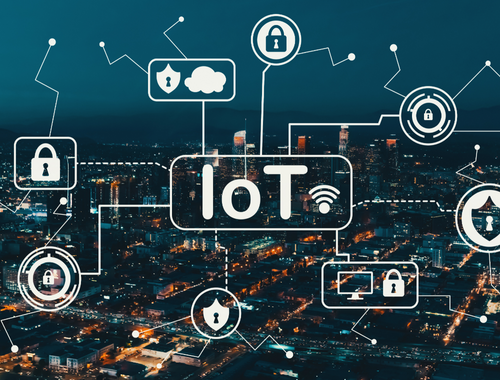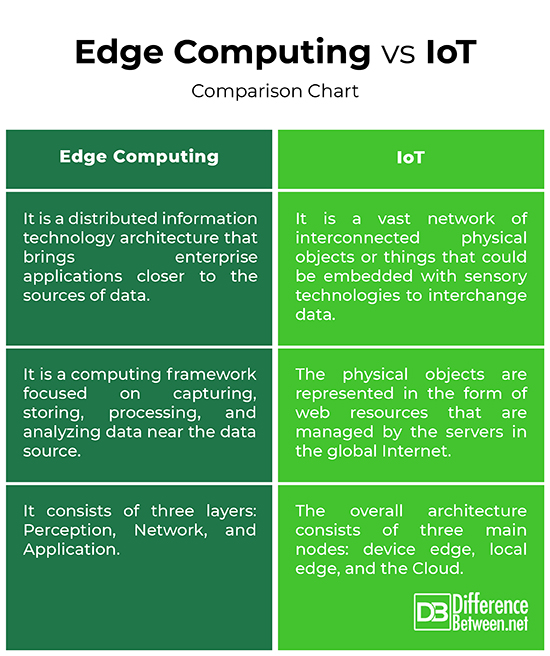Difference Between Edge Computing and IoT
We live in a connected world where more people are connected than ever before. And IoT (Internet of Things) refers to the collective network of billions of physical devices all around us that are connected to the Internet. These devices generate data in unimaginable volumes, management and storage of which are equally important. But such data in their original form do not have any use unless mined for valuable information. This requires domain specific knowledge, valuable experience, and technical know-how of real experts. To meet the increasing demands of various IoT applications and services, leading ICT companies are working with their own cloud-based IoT platforms for data-centric services. IoT and edge computing are two closely affiliated technologies that play a central role in all this.

What is Edge Computing?
Edge computing is a distributed information technology architecture that brings enterprise applications closer to the sources of data. It is an emerging computing paradigm that refers to a wide range of devices and networks at or near the physical location of the user or the data source. The term ‘edge’ here in this context means literal geographic distribution. It is part of a distributed computing topology wherein information is processed at the edge, instead of in a centralized location. Edge systems are extensions of general IT-managed components which are essentially remote computing systems and take elements from already established engineering domains of cloud computing, embedded systems, information security, and so on. Edge computing is one of the most efficient ways for a company to use and distribute a common pool of resources across multiple locations.

What is Internet of Things (IoT)?
The term IoT has generated a lot of interests and hype in the past couple of years. The term can be most likely attributed to the British technology pioneer Kevin Ashton who actually coined the term IoT to describe the network connecting objects in the physical world to the Internet, during his work at Procter & Gamble. It was his work that brought him to MIT in 1999 where he and a bunch of like-minded talents started the Auto-ID Center research consortium at the Massachusetts. Since then, IoT has started gaining traction and has grown from simple RFID tags to a whole ecosystem of Internet connected devices. And the scale of connected objects is unprecedented. Today, IoT applications span across every segment in industrial, enterprise, health, and consumer products. In fact, Industrial IoT is one of the fastest growing segments in the overall IoT space.
Difference between Edge Computing and IoT
Definition
– Edge computing is a distributed information technology architecture that brings enterprise applications closer to the sources of data, instead of in a centralized location. It is a computing framework focused on capturing, storing, processing, and analyzing data near the data source, where the data is generated. Internet of Things (IoT) is a vast network of interconnected physical objects or things that could be embedded with sensory technologies or software that allow them to interchange data. The physical objects are represented in the form of web resources that are managed by the servers in the global Internet.
Architecture
– IoT refers to a comprehensive environment wherein a large number of physical devices or objects such as appliances, facilities, vehicles, farms, factories, etc. are interconnected via the Internet. An IoT system follows the architecture of the cloud-centric Internet of Things which basically consists of three layers: Perceptions (devices, sensors, etc.), Network (connectivity between devices), and Application (the user interaction layer). Edge is a distributed computing architecture in which client data is processed and analyzed at the periphery of the network. The overall architecture consists of three main nodes: device edge, local edge, and the Cloud.
Use Cases
– Some of the most common applications of IoT are autonomous vehicles, smart homes, supply chain management , smartwatches, activity trackers, smart home devices, smart surveillance, virtual assistants, location tracking, vehicle fleet management, predictive maintenance, and more. Some use cases common with edge computing are industrial control systems, patient monitoring, content delivery, cloud gaming, resilient communication management, video streaming, mobile entertainment, IoT processing, and so on.
Edge Computing vs. IoT: Comparison Chart

Summary
Both IoT and edge computing are two different technologies that work together to make our everyday lives easier. IoT devices are like physical objects that communicate real-time data to a network whereas edge computing brings data or information processing as close to IoT devices as possible. Both IoT and edge represent a paradigm shift in data gathering and analysis. Edge computing goes hand-in-hand with many other prominent technologies, including the Internet of Things. So, they are complementary technologies that depend on each other to provide greater benefits to both individuals and businesses.
What is the edge in IoT?
IoT and edge are powerful technologies that work together to achieve different objectives. They are a powerful way to process and analyze data in real time saving individuals and businesses a great deal of time.
What are the advantages of using IoT with edge computing?
IoT devices collect data and edge devices process them at the source to provide meaningful insights for enterprises. So, edge computing basically provides an IoT system with a local source where data can be processes, stored and analyzed.
How is edge computing implemented in IoT?
Edge computing is a strategy for computing at source and it does that by streamlining the traffic flow from IoT devices. The IoT is a platform where everyday devices become smarter and everyday processing becomes more intelligent.
Is edge computing part of AI?
AI is a perfect candidate for edge computing. In fact, edge is the catalyst for AI, crafting AI workflows that span centralized data centers.
- Difference Between Caucus and Primary - June 18, 2024
- Difference Between PPO and POS - May 30, 2024
- Difference Between RFID and NFC - May 28, 2024
Search DifferenceBetween.net :
Leave a Response
References :
[0]Chen, Xu, et al. Intelligent IoT for the Digital World: Incorporating 5G Communications and Fog/Edge Computing Technologies. New Jersey, United States: John Wiley & Sons, 2021. Print
[1]Srirama, Satish Narayana and Rajkumar Buyya. Fog and Edge Computing: Principles and Paradigms. New Jersey, United States: John Wiley & Sons, 2019. Print
[2]Lea, Perry. IoT and Edge Computing for Architects: Implementing Edge and IoT Systems from Sensors to Clouds with Communication Systems, Analytics, and Security (2nd Edition). Birmingham, United Kingdom: Packt Publishing, 2020. Print
